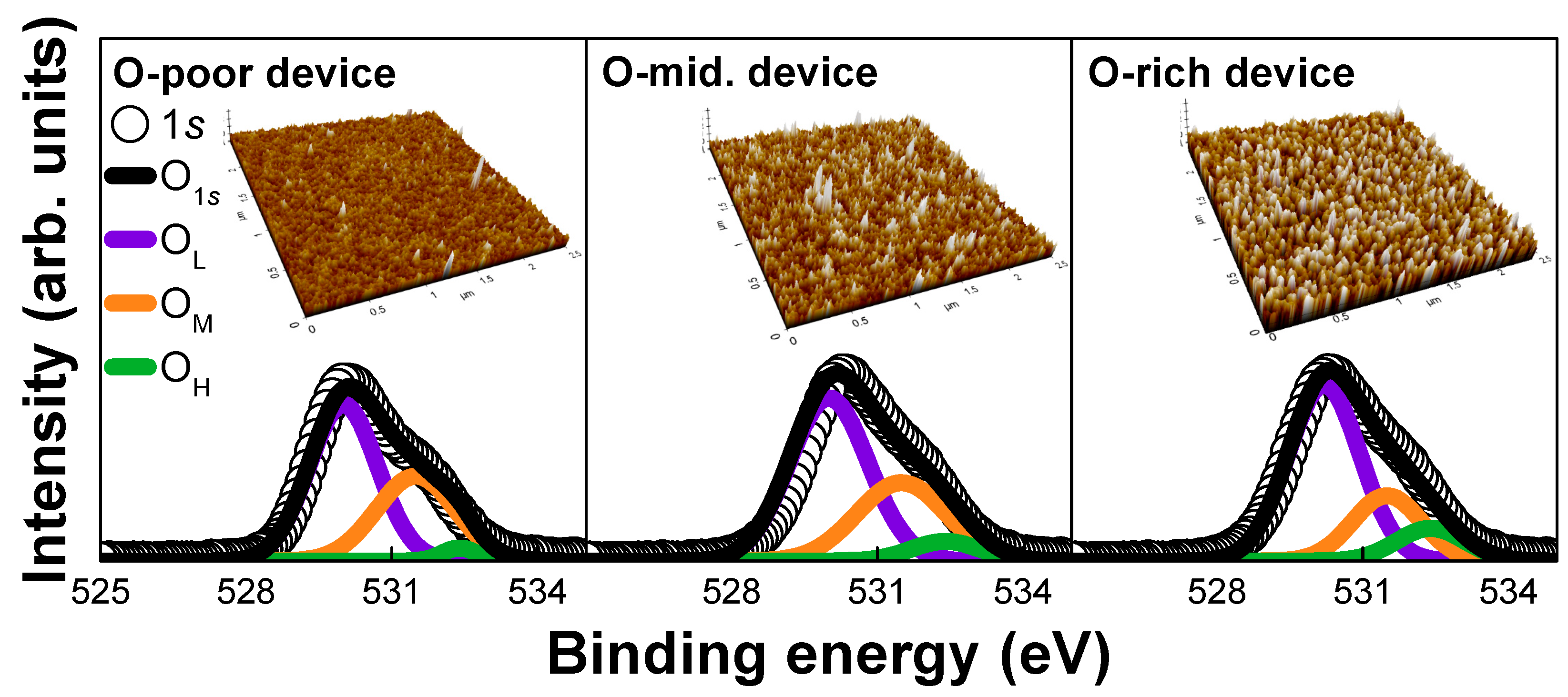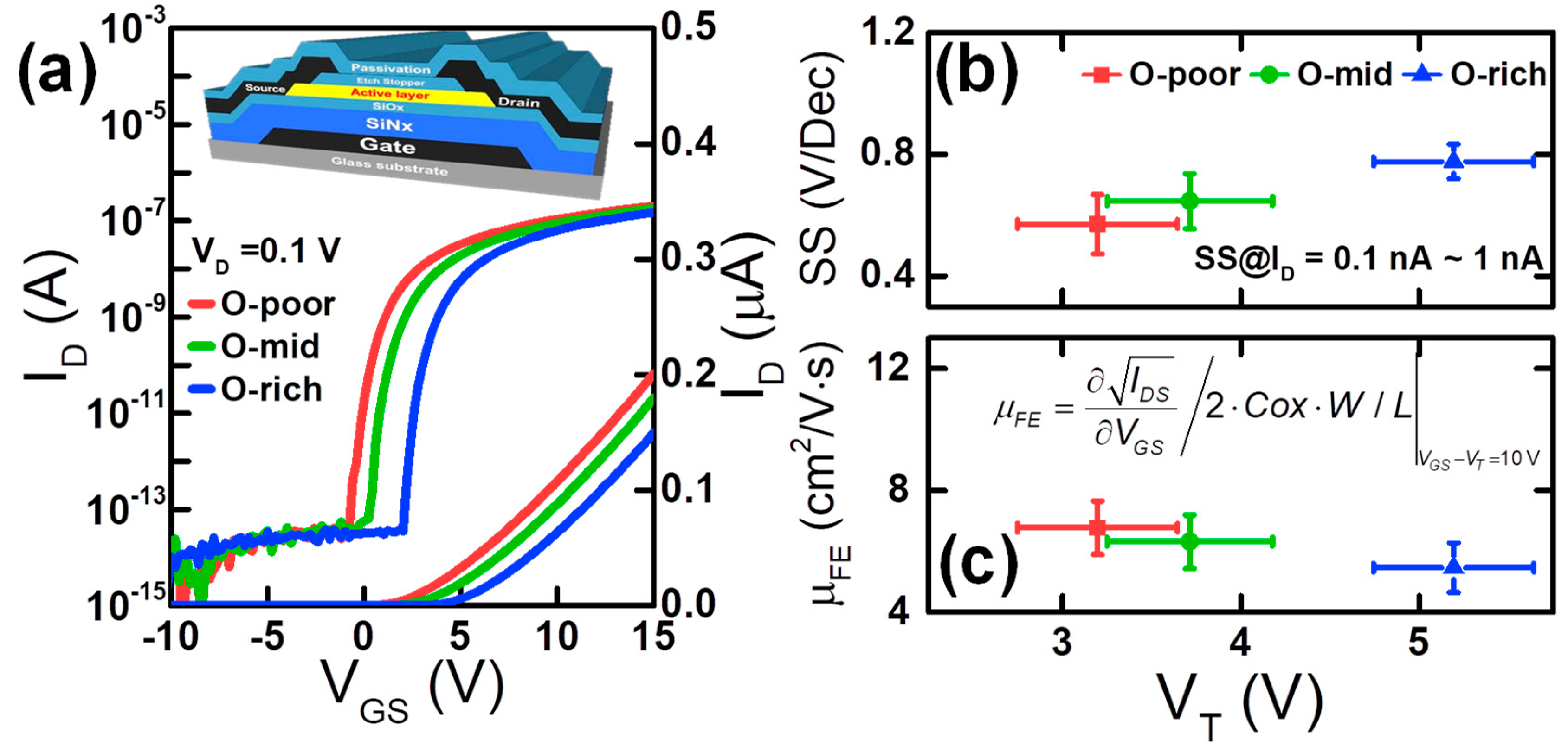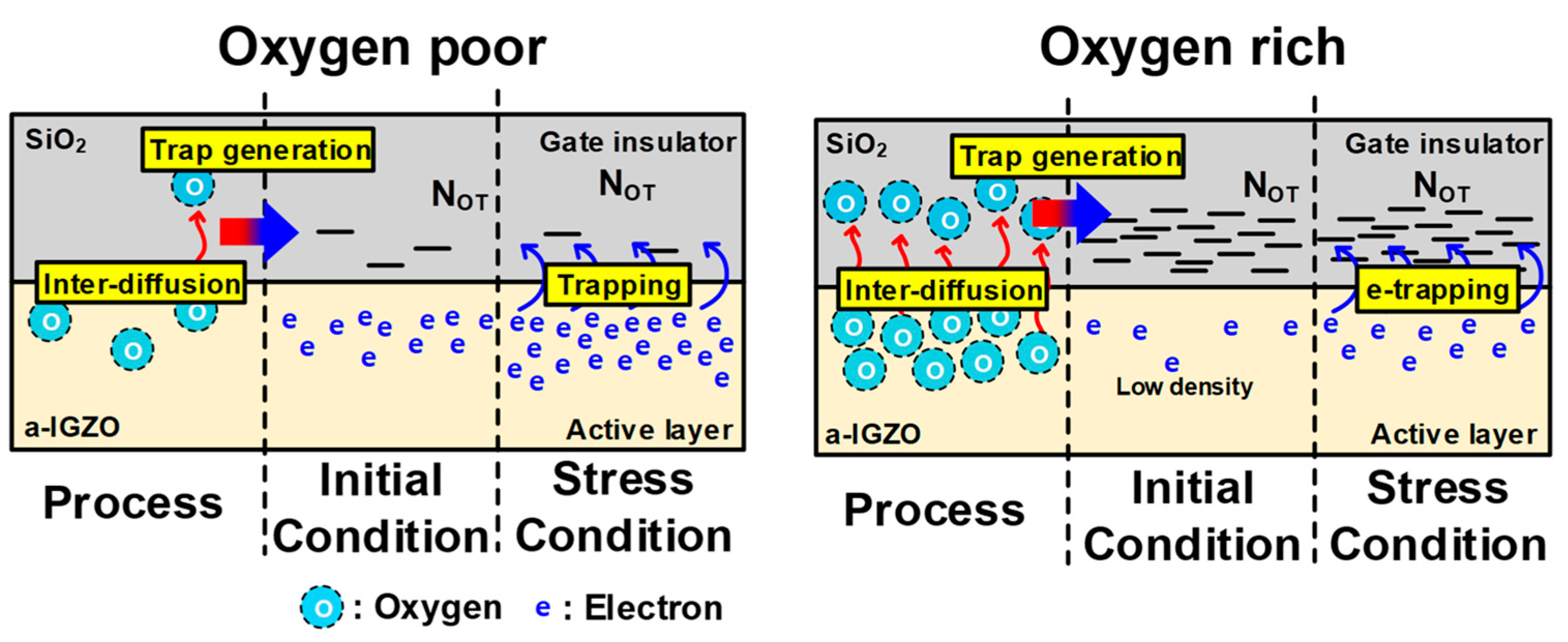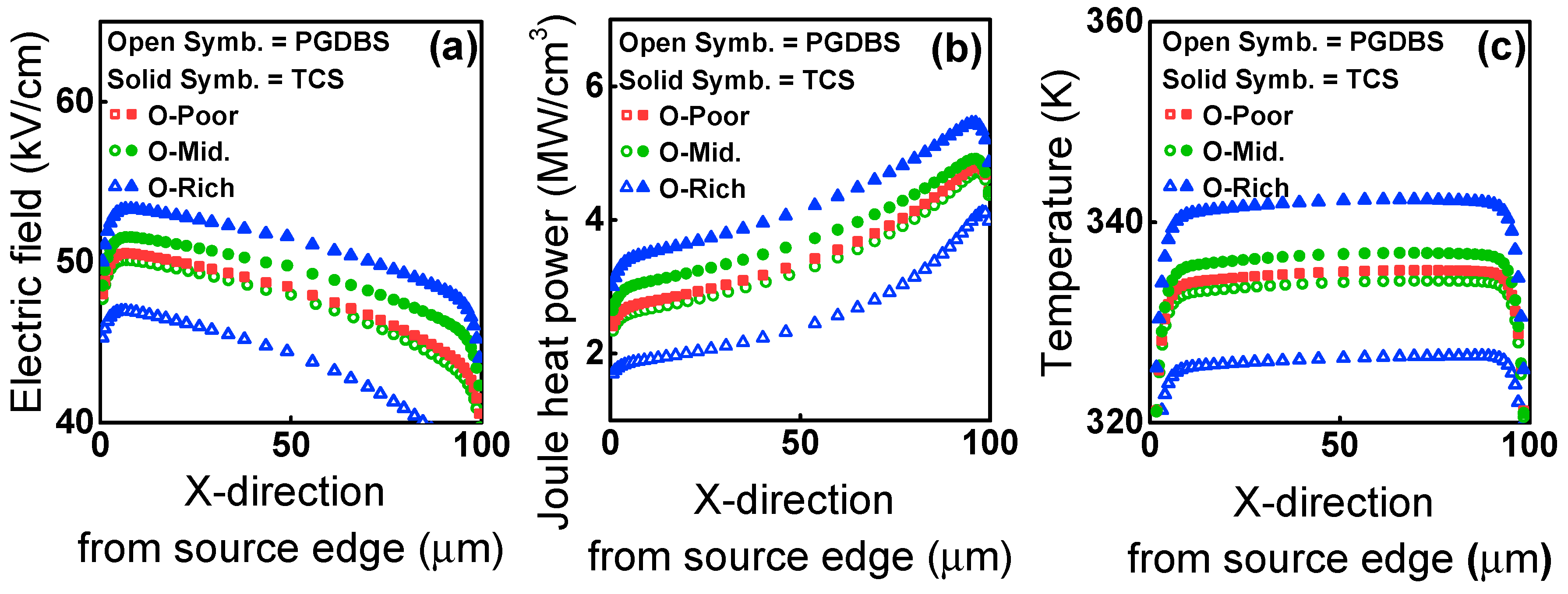Effect of Oxygen Content on Current Stress-Induced Instability in Bottom-Gate Amorphous InGaZnO Thin-Film Transistors
Abstract
1. Introduction
2. Experimental Procedure and Material Properties
3. Results and Discussion
4. Conclusions
Author Contributions
Funding
Acknowledgments
Conflicts of Interest
References
- Tani, R.; Yoon, J.; Yun, S.-I.; Nam, W.; Takasugi, S.; Kim, J.-M.; Park, J.; Kwon, S.; Kim, P.; Oh, C.; et al. 64.2: Panel and Circuit Designs for the World’s First 65-inch UHD OLED TV. SID Symp. Dig. Tech. Pap. 2015, 46, 950–953. [Google Scholar] [CrossRef]
- Kim, J.; Bang, S.; Lee, S.; Shin, S.; Park, J.; Seo, H.; Jeon, H. A study on H 2 plasma treatment effect on a-IGZO thin film transistor. J. Mater. Res. 2012, 27, 2318–2325. [Google Scholar] [CrossRef]
- Chen, W.-T.; Lo, S.-Y.; Kao, S.-C.; Zan, H.-W.; Tsai, C.-C.; Lin, J.-H.; Fang, C.-H.; Lee, C.-C. Oxygen-Dependent Instability and Annealing/Passivation Effects in Amorphous In-Ga-Zn-O Thin-Film Transistors. IEEE Electron. Dev. Lett. 2011, 32, 1552–1554. [Google Scholar] [CrossRef]
- Kim, K.A.; Park, M.J.; Lee, W.H.; Yoon, S.M. Characterization of negative bias-illumination-stress stability for transparent top-gate In-Ga-Zn-O thin-film transistors with variations in the incorporated oxygen content. J. Appl. Phys. 2015, 118. [Google Scholar] [CrossRef]
- Nomura, K.; Kamiya, T.; Hosono, H. Effects of diffusion of hydrogen and oxygen on electrical properties of amorphous oxide semiconductor, In-Ga-Zn-O. ECS J. Solid State Sci. Technol. 2012, 2, P5–P8. [Google Scholar] [CrossRef]
- Moon, Y.-K.; Lee, S.; Kim, D.-H.; Lee, D.-H.; Jeong, C.-O.; Park, J.-W. Application of DC magnetron sputtering to deposition of ingazno films for thin film transistor devices. Jpn. J. Appl. Phys. 2009, 48, 031301. [Google Scholar] [CrossRef]
- Nomura, K.; Takagi, A.; Kamiya, T.; Ohta, H.; Hirano, M.; Hosono, H. Amorphous oxide semiconductors for high-performance flexible thin-film transistors. Jpn. J. Appl. Phys. 2006, 45, 4303–4308. [Google Scholar] [CrossRef]
- Zhan, R.; Dong, C.; Liu, P.-T.; Shieh, H.-P.D. Influence of channel layer and passivation layer on the stability of amorphous In-Ga-Zn-O thin film transistors. Microelectron. Reliab. 2013, 53, 1879–1885. [Google Scholar] [CrossRef]
- Mtangi, W.; Auret, F.D.; Meyer, W.E.; Legodi, M.J.; Janse van Rensburg, P.J.; Coelho, S.M.M.; Diale, M.; Nel, J.M. Effects of hydrogen, oxygen, and argon annealing on the electrical properties of ZnO and ZnO devices studied by current-voltage, deep level transient spectroscopy, and Laplace DLTS. J. Appl. Phys. 2012, 111, 094504. [Google Scholar] [CrossRef]
- Lee, S.; Park, S.; Kim, S.; Jeon, Y.; Jeon, K.; Park, J.-H.; Park, J.; Song, I.; Kim, C.-J.; Park, Y.; et al. Extraction of subgap density of states in amorphous InGaZnO thin-film transistors by using multifrequency capacitanc-voltage characteristics. Electron. Device Lett. 2010, 31, 231–233. [Google Scholar]
- Kim, S.; Jeon, Y.W.; Kim, Y.; Kong, D.; Jung, H.K.; Bae, M.-K.; Lee, J.-H.; Du Ahn, B.; Park, S.Y.; Park, J.-H.; et al. Impact of oxygen flow rate on the instability under positive bias stresses in dc-sputtered amorphous In-Ga-Zn-O thin-film transistors. IEEE Electron. Device Lett. 2012, 33, 62–64. [Google Scholar] [CrossRef]
- Kamiya, T.; Nomura, K.; Hirano, M.; Hosono, H. Electronic structure of oxygen deficient amorphous oxide semiconductor a-InGaZnO 4-x: Optical analyses and first-principle calculations. Phys. Stat. Solidi 2008, 5, 3098–3100. [Google Scholar]
- Janotti, A.; Van de Walle, C.G. Oxygen vacancies in ZnO. Appl. Phys. Lett. 2005, 87, 122102. [Google Scholar] [CrossRef]
- Nomura, K.; Ohta, H.; Takagi, A.; Kamiya, T.; Hirano, M.; Hosono, H. Room-temperature fabrication of transparent flexible thin-film transistors using amorphous oxide semiconductors. Nature 2004, 432, 488–492. [Google Scholar] [CrossRef] [PubMed]
- Lee, J.-M.; Cho, I.-T.; Lee, J.-H.; Kwon, H.-I. Bias-stress-induced stretched-exponential time dependence of threshold voltage shift in InGaZnO thin film transistors. Appl. Phys. Lett. 2008, 93, 2–5. [Google Scholar] [CrossRef]
- Suresh, A.; Muth, J.F. Bias stress stability of indium gallium zinc oxide channel based transparent thin film transistors. Appl. Phys. Lett. 2008, 92, 033502. [Google Scholar] [CrossRef]
- Um, J.G.; Mativenga, M.; Migliorato, P.; Jang, J. Defect generation in amorphous-indium-gallium-zinc-oxide thin-film transistors by positive bias stress at elevated temperature. J. Appl. Phys. 2014, 115, 134502. [Google Scholar] [CrossRef]
- Mativenga, M.; Hong, S.; Jang, J. High current stress effects in amorphous-In-Ga-Zn-O4 thin-film transistors. Appl. Phys. Lett. 2013, 102, 1–4. [Google Scholar] [CrossRef]
- Kim, J.I.; Jeong, C.-Y.; Kwon, H.-I.; Jung, K.D.; Park, M.S.; Kim, K.H.; Seo, M.S.; Lee, J.-H. Modeling of asymmetric degradation based on a non-uniform electric field and temperature in amorphous In-Ga-Zn-O thin film transistors. Semicond. Sci. Technol. 2017, 32, 035017. [Google Scholar] [CrossRef]
- Lee, D.; Jeong, C.-Y.; Song, S.-H.; Xiao-Shi, J.; Kim, J.I.; Lee, J.-H.; Kwon, H.-I. Asymmetrical degradation behaviors in amorphous In-Ga-Zn-O thin-film transistors under various gate and drain bias stresses. J. Vac. Sci. Technol. B Nanotechnol. Microelectron. Mater. Process. Meas. Phenom. 2015, 33, 011202. [Google Scholar]
- Choi, S.; Jang, J.; Kang, H.; Baeck, J.H.; Bae, J.U.; Park, K.-S.; Yoon, S.Y.; Kang, I.B.; Kim, D.M.; Choi, S.-J.; et al. Systematic decomposition of the positive bias stress instability in self-aligned coplanar In-Ga-Zn-O thin-film transistors. IEEE Electron. Dev. Lett. 2017, 38, 580–583. [Google Scholar] [CrossRef]
- Choi, S.; Kim, H.; Jo, C.; Kim, H.-S.; Choi, S.-J.; Kim, D.M.; Park, J.; Kim, D.H. The effect of gate and drain fields on the competition between donor-like state creation and local electron trapping in In–Ga–Zn–O thin film transistors under current stress. IEEE Electron. Device Lett. 2015, 36, 1336–1339. [Google Scholar] [CrossRef]
- Nahm, H.-H.; Kim, Y.-S.; Kim, D.H. Instability of amorphous oxide semiconductors via carrier-mediated structural transition between disorder and peroxide state. Phys. Stat. Solidi 2012, 249, 1277–1281. [Google Scholar] [CrossRef]
- Oh, S.; Baeck, J.H.; Bae, J.U.; Park, K.-S.; Kang, I.B. Effect of interfacial excess oxygen on positive-bias temperature stress instability of self-aligned coplanar In-Ga-Zn-O thin-film transistors. Appl. Phys. Lett. 2016, 108, 141604. [Google Scholar] [CrossRef]
- Li, F.; Nathan, A. CCD Image Sensors in Deep-Ultraviolet; Microtechnology and Mems; Springer: Berlin/Heidelberg, Germany, 2005; ISBN 3-540-22680-X. [Google Scholar]
- Chen, T.-C.; Chang, T.-C.; Hsieh, T.-Y.; Tsai, M.-Y.; Chen, Y.-T.; Chung, Y.-C.; Ting, H.-C.; Chen, C.-Y. Self-heating enhanced charge trapping effect for In-Ga-Zn-O thin film transistor. Appl. Phys. Lett. 2012, 101, 042101. [Google Scholar] [CrossRef]
- Kim, J.I.; Chang, K.S.; Kim, D.U.; Cho, I.-T.; Jeong, C.-Y.; Lee, D.; Kwon, H.-I.; Jin, S.H.; Lee, J.-H. Thermoreflectance microscopy analysis on self-heating effect of short-channel amorphous In-Ga-Zn-O thin film transistors. Appl. Phys. Lett. 2014, 105, 043501. [Google Scholar] [CrossRef]
- Urakawa, S.; Tomai, S.; Ueoka, Y.; Yamazaki, H.; Kasami, M.; Yano, K.; Wang, D.; Furuta, M.; Horita, M.; Ishikawa, Y.; et al. Thermal analysis of amorphous oxide thin-film transistor degraded by combination of joule heating and hot carrier effect. Appl. Phys. Lett. 2013, 102, 2011–2015. [Google Scholar] [CrossRef]
- Yoshikawa, T.; Yagi, T.; Oka, N.; Jia, J.; Yamashita, Y.; Hattori, K.; Seino, Y.; Taketoshi, N.; Baba, T.; Shigesato, Y. Thermal Conductivity of amorphous Indium-Gallium-Zinc Oxide thin films. Appl. Phys. Express 2013, 6, 021101. [Google Scholar] [CrossRef]
- ATLAS User’s Manual; Silvaco: Santa Clara, CA, USA, 2018.








| O-Content | O-Poor | O-Medium | O-Rich | |
|---|---|---|---|---|
| OL | NL (A.U) | 1.20 × 105 | 1.25 × 105 | 1.30 × 105 |
| KTL (eV) | 1 | |||
| EL (eV) | 530 | |||
| OM | NM (A.U.) | 0.65 × 105 | 0.60 × 105 | 0.50 × 105 |
| KTM (eV) | 1.15 | 1.1 | 1.1 | |
| EM (eV) | 531.5 | |||
| OH | NH (A.U.) | 0.10 × 105 | 0.2 × 105 | 0.25 × 105 |
| KTH (eV) | 0.5 | 0.75 | 1 | |
| EH (eV) | 532.4 | |||
| Parameter | O-Content | Stress Condition | Ndos (eV−1 cm−3) | kTdos (eV) | Edos (eV) |
|---|---|---|---|---|---|
| gTA (E) | O-poor | All conditions | 2.0 × 1019 | 0.06 | – |
| O-mid | All conditions | 2.3 × 1019 | 0.065 | – | |
| O-rich | All conditions | 3.0 × 1019 | 0.075 | – | |
| gDA (E) | O-poor | All conditions | 1.5 × 1017 | 0.4 | – |
| O-mid | All conditions | 1.6 × 1017 | 0.47 | – | |
| O-rich | All conditions | 1.9 × 1017 | 0.5 | – | |
| gSD (E) | O-poor | Initial | – | 0.4–0.45 | 0.3 |
| After PGBS | – | ||||
| After PGDBS | 5 × 1017 | ||||
| After TCS | 6 × 1017 | ||||
| O-mid | Initial | – | |||
| After PGBS | – | ||||
| After PGDBS | 3 × 1017 | ||||
| After TCS | 3 × 1017 | ||||
| O-rich | Initial | – | |||
| After PGBS | – | ||||
| After PGDBS | 2 × 1017 | ||||
| After TCS | 3 × 1017 |
© 2019 by the authors. Licensee MDPI, Basel, Switzerland. This article is an open access article distributed under the terms and conditions of the Creative Commons Attribution (CC BY) license (http://creativecommons.org/licenses/by/4.0/).
Share and Cite
Choi, S.; Kim, J.-Y.; Kang, H.; Ko, D.; Rhee, J.; Choi, S.-J.; Kim, D.M.; Kim, D.H. Effect of Oxygen Content on Current Stress-Induced Instability in Bottom-Gate Amorphous InGaZnO Thin-Film Transistors. Materials 2019, 12, 3149. https://doi.org/10.3390/ma12193149
Choi S, Kim J-Y, Kang H, Ko D, Rhee J, Choi S-J, Kim DM, Kim DH. Effect of Oxygen Content on Current Stress-Induced Instability in Bottom-Gate Amorphous InGaZnO Thin-Film Transistors. Materials. 2019; 12(19):3149. https://doi.org/10.3390/ma12193149
Chicago/Turabian StyleChoi, Sungju, Jae-Young Kim, Hara Kang, Daehyun Ko, Jihyun Rhee, Sung-Jin Choi, Dong Myong Kim, and Dae Hwan Kim. 2019. "Effect of Oxygen Content on Current Stress-Induced Instability in Bottom-Gate Amorphous InGaZnO Thin-Film Transistors" Materials 12, no. 19: 3149. https://doi.org/10.3390/ma12193149
APA StyleChoi, S., Kim, J.-Y., Kang, H., Ko, D., Rhee, J., Choi, S.-J., Kim, D. M., & Kim, D. H. (2019). Effect of Oxygen Content on Current Stress-Induced Instability in Bottom-Gate Amorphous InGaZnO Thin-Film Transistors. Materials, 12(19), 3149. https://doi.org/10.3390/ma12193149





